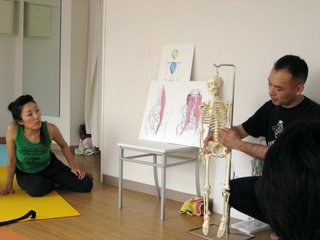 Next we moved on to healthy walking by using the psoas muscle. Kaz gave us a lot of small exercises we can do to improve these fundamental functions. I'll write a blog in the near future that will illustrate these exercises for you!
Next we moved on to healthy walking by using the psoas muscle. Kaz gave us a lot of small exercises we can do to improve these fundamental functions. I'll write a blog in the near future that will illustrate these exercises for you!After the workshop we went to a cafe and had an informal interview with Kaz. Here are some excerpts from it. He's a really interesting guy!
Yoga Garden: You used to be a manager for a home construction company. Why did you change to a career in health?

Kaz: I had a proffessor in university who told our class that we should go into one of three fields, clothing, food, or housing, because those are three things that people will always need. I went into housing with the construction company, but I started to think that there was an even more important thing for life, your health. Which is more important for you, a nice house, or your health? Also, I didn't like working for a company. I don't like to have a boss, and I don't like to be the boss.
YG: There are many kinds of health therapies, why did you choose Rolfing?
Kaz: Most forms of massage focus on the body one area at a time, the shoulders, or the feet, for example. I was interested in changing the whole structure of the body, for a long term effect. So I chose Rolfing.
YG: How exactly does Rolfing help people?
Kaz: All of our muscles are surrounded by a thin layer of tissue. This is the fascia. If you ever buy a piece of uncooked chicken, you can see the fascia, it is the thin white covering over the meat. Over time, the fascia becomes tight and locked up. Right now you are wearing a T-shirt. Imagine the muscle is your arm, and the sleeve of your T-shirt is the fascia. (Kaz sketches this picture on an envelope)
buy a piece of uncooked chicken, you can see the fascia, it is the thin white covering over the meat. Over time, the fascia becomes tight and locked up. Right now you are wearing a T-shirt. Imagine the muscle is your arm, and the sleeve of your T-shirt is the fascia. (Kaz sketches this picture on an envelope)
If I hold your sleeve very tightly around your arm, it's hard to move your arm isn't it? It is the same for fascia that is locked up. With strong pressure, the fascia can be loosened up, which allows your posture to improve, and your movements to become smoother, and more efficient. buy a piece of uncooked chicken, you can see the fascia, it is the thin white covering over the meat. Over time, the fascia becomes tight and locked up. Right now you are wearing a T-shirt. Imagine the muscle is your arm, and the sleeve of your T-shirt is the fascia. (Kaz sketches this picture on an envelope)
buy a piece of uncooked chicken, you can see the fascia, it is the thin white covering over the meat. Over time, the fascia becomes tight and locked up. Right now you are wearing a T-shirt. Imagine the muscle is your arm, and the sleeve of your T-shirt is the fascia. (Kaz sketches this picture on an envelope)YG: Can a person feel their own fascia?
Kaz: It takes a little practice, but you can feel your fascia. Someone told me that if you press on your skin with as much pressure as it would take to squish an ant, that's the point where you are making contact with the fascia, but I don't know if that's true, I never tried really squishing an ant!
YG: The pressure used in Rolfing can be painful, right?
Kaz: Sometimes, especially problem areas in the fascia, where there are a lot of nerve endings, can be painful. I do not enter the patient's boundary of too much pain, however. There is usually another way to work with that area that is less uncomfortable.
YG: Do you have some clients who are skeptical about the benefits of Rolfing?
Kaz: Yes, once that happened. A client said he couldn't feel any changes in his body after a session. That's ok. I didn't mind, because I could see the changes in him. But almost all of my clients feel a big difference after just one Rolfing session.
YG: How can Yoga and Rolfing work together?
Kaz: Since I started doing yoga with you guys, I have noticed that my movement has improved a lot. So maybe Rolfing can prepare the body structure for more efficient movement, and yoga can teach that efficient movement. I see some yoga students having trouble with balancing poses, like tree pose, and I think that if their structure was improved, they would have an easier time with that pose. There are many connections between Rolfing and yoga, I think. We have to discover them together!
Thanks Kaz, for a great workshop! If you're interested in learning more about Rolfing, check the Rolfing Institute homepage, or Kaz's homepage here. We had such a good time doing this workshop that we want to arrange "Mechanics of Movement, Part 2" in the coming months. The second workshop will focus on the two girdles, shoulders, and pelvis. Keep checking the workshop homepage for more information.
Patrick
Yoga Garden


No comments:
Post a Comment